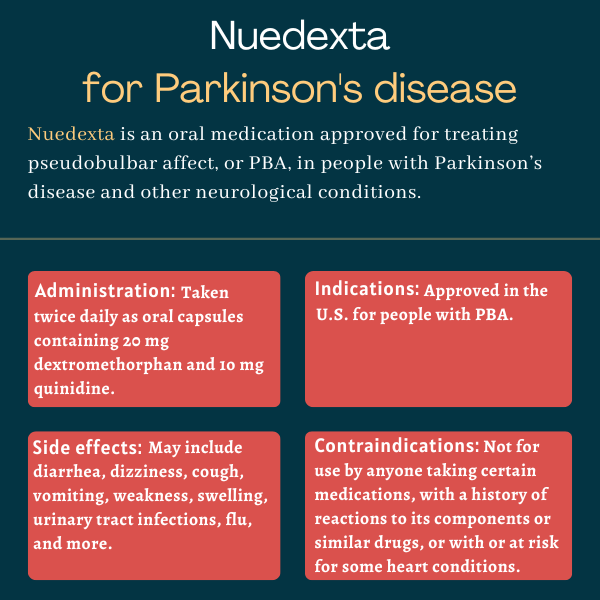
Nuedexta (dextromethorphan hydrobromide and quinidine sulfate) for Parkinson’s disease
Last updated April 25, 2024, by Lindsey Shapiro, PhD

What is Nuedexta for Parkinson’s disease?
Nuedexta (dextromethorphan hydrobromide and quinidine sulfate) is an oral combination therapy that’s approved to treat pseudobulbar affect, or PBA, a condition marked by uncontrolled laughing or crying that can affect people with Parkinson’s disease and other neurological conditions.
The involuntary outbursts of laughter or crying seen in PBA often do not reflect the person’s real emotional state, and can be mistaken as signs of other symptoms. These uncontrollable episodes are thought to affect as many as nearly one-quarter of Parkinson’s patients.
The medication was developed by Avanir Pharmaceuticals, which is now part of Otsuka America Pharmaceuticals. A generic version of Nuedexta is also available.
Therapy snapshot
| Brand name: | Nuedexta |
| Chemical name: | Dextromethorphan hydrobromide and quinidine sulfate |
| Usage: | Used to treat pseudobulbar affect in Parkinson’s and other neurological conditions |
| Administration: | Oral capsules |
How does Nuedexta work?
Pseudobulbar affect, or PBA for short, is characterized by involuntary, sudden episodes of laughing or crying that are not associated with a person’s actual emotional state. This condition is caused by damage or dysfunction of brain regions that control emotional expression, which can stem from Parkinson’s disease as well as other neurodegenerative conditions or brain injuries.
The exact mechanism by which Nuedexta controls PBA is not fully known, but it is presumed to work by reducing the activity of glutamate, a brain signaling molecule that’s thought to be involved in PBA.
The medication is a fixed dose combination of two approved drugs: dextromethorphan and quinidine.
Dextromethorphan, a medication widely used to relieve cough, specifically binds to sigma-1 receptors, which is thought to block the release of glutamate from nerve cells. It also binds to NMDA receptors, where glutamate normally exerts its effects, reducing the amount of glutamate that is able to bind those receptors.
Quinidine, which is used to treat irregular heartbeat and also as an anti-malarial medication, is an inhibitor of the CYP2D6 enzyme. It is believed to extend dextromethorphan’s availability in the bloodstream and prolong its effects.
Who can take Nuedexta?
Nuedexta was approved by the U.S. Food and Drug Administration (FDA) in October 2010 for the treatment of pseudobulbar affect. That decision marked the first approval of a treatment for this condition.
The medication gained a similar approval in the European Union in June 2o13, but its developer withdrew it from the market in 2016 for commercial reasons.
Who should not take Nuedexta?
Nuedexta is contraindicated, or not recommended, for people with certain medical conditions or histories:
- The therapy should not be used by anyone taking other medications containing quinidine or similar anti-malarial compounds, namely quinine or mefloquine.
- It should not be given to individuals who have previously experienced certain hypersensitivity reactions to quinidine, quinine, or mefloquine. Such reactions include low blood platelet counts, known as thrombocytopenia, hepatitis, bone marrow depression, or lupus-like syndrome.
- The therapy should not be used by anyone with a history of allergic reactions to dextromethorphan.
- Treatment should not be given to individuals who are using or have used monoamine oxidase inhibitors (MAOIs), which include certain Parkinson’s disease therapies, in the previous two weeks. Patients also should wait two weeks after stopping Nuedexta before starting an MAOI.
- It should not be used by patients who have certain heart conditions, including a prolonged QT interval (the time it takes for the heart’s ventricles to recharge during a heartbeat), congenital long QT syndrome, a history of torsades de pointes, or heart failure.
- The therapy should not be given to individuals using medications that are metabolized by the CYPD2D6 enzyme and may prolong QT interval.
- The treatment should not be used by anyone who has or may be at a high risk for complete atrioventricular block without a pacemaker. Atrioventricular block is when electrical signals can’t pass normally from the heart’s upper chambers to the lower chambers.
How is Nuedexta administered in Parkinson’s?
Nuedexta is available in the form of oral gelatin capsules, each containing 20 mg dextromethorphan hydrobromide and 10 mg quinidine sulfate. Capsules are brick red and labeled with “DMQ 20-10” in white.
For the first seven days, patients should take one daily capsule, by mouth, in the morning. The capsules should then be taken twice daily: one in the morning and one in the evening, approximately 12 hours apart, and with or without food.
Patients should not take more than two Nuedexta capsules during a 24-hour period. Thus, if a dose is missed, the next dose should be taken at the usual time, instead of taking a double dose.
Because PBA can spontaneously improve for some people, the need for continued treatment should be reassessed periodically.

Nuedexta in clinical trials
A number of clinical trials have evaluated the use of Nuedexta in various patient populations. It has now been tested among those with Parkinson’s disease, amyotrophic lateral sclerosis (ALS), multiple sclerosis (MS), dementia, stroke, and traumatic brain injury.
STAR Phase 3 trial
Nuedexta’s approval was largely backed by data from the Phase 3 STAR trial (NCT00573443), which enrolled 326 adults with ALS or MS and clinically significant PBA.
Participants were randomly assigned to receive Nuedexta at its now-approved dose (20 mg dextromethorphan/10 mg quinidine), a higher dose containing 30 mg dextromethorphan and 10 mg quinidine, or a placebo for 12 weeks, or about three months. Capsules were taken once daily for the first week, and then every 12 hours for the remainder of the trial.
The results demonstrated that all of the groups experienced substantial reductions in the frequency of daily PBA episodes of laughing or crying. However, those given Nuedexta experienced significantly greater reductions than patients given the placebo.
The now-approved dose notably led to a 49% greater reduction in PBA episodes than did the placebo after three months, with significant differences between the groups observed as early as one week after starting treatment.
After 12 weeks, Nuedexta-treated patients experienced a mean of 3.9 fewer daily episodes than they did at the study’s start. That compared with a mean reduction of three daily episodes among those in the placebo group. Also, a larger proportion of patients on Nuedexta achieved remission (51% vs. 29%), defined as no PBA episodes in the final two weeks of the trial.
Trials involving Parkinson’s patients
A large, open-label Phase 3 clinical trial (NCT00056524) evaluated the long-term safety of Nuedexta in 553 adults with a variety of neurological conditions. Among them were 11 Parkinson’s disease patients. All received Nuedexta at a dose of 30 mg dextromethorphan/30 mg quinidine for one year.
The treatment was generally well tolerated, with common side effects such as nausea, dizziness, headache, sleepiness, fatigue, diarrhea, and dry mouth. Serious side effects were reported in 22.8% of patients, but none was deemed related to Nuedexta treatment.
A Phase 2a pilot study (NCT01767129) also examined the safety and efficacy of Nuedexta for the treatment of dyskinesia, or involuntary movements, caused by levodopa therapy in Parkinson’s disease patients.
A total of 13 patients were randomly assigned to Nuedexta — 45 mg dextromethorphan/10 mg quinidine — or a placebo for two weeks. Treatment was given once daily for three days, then twice daily thereafter. Then, after a washout period, which allowed the medications to be processed out of the body, all crossed over to the other treatment arm for another two weeks.
On the final day of each treatment period, patients received an infusion of levodopa and were examined for the presence of dyskinesia.
The use of Nuedexta led to significantly less dyskinesia severity at the end of the levodopa infusion than did the placebo, the results showed. A total of nine patients (69.2%) also rated their dyskinesia as much or very much improved while on Nuedexta. Meanwhile, one patient (7.7%) reported such an improvement while receiving the placebo.
Common side effects of Nuedexta
The most common side effects associated with Nuedexta treatment in clinical trials included:
- diarrhea
- dizziness
- cough
- vomiting
- abnormal weakness or lack of energy (asthenia)
- swelling of the hands or feet (peripheral edema)
- urinary tract infection
- influenza
- increased levels of gamma-glutamyltransferase, a sign of liver damage
- flatulence.
Low platelet levels and other immune-related reactions
Quinidine can cause immune-mediated thrombocytopenia, or low blood platelet counts. Platelets are involved in blood clotting, thus this condition increases the risk of bleeding events that could be severe or fatal if the medication is continued.
Symptoms that may precede or occur with thrombocytopenia include lightheadedness, chills, fever, nausea, or vomiting. If thrombocytopenia occurs and is possibly related to the medication, Nuedexta should be discontinued immediately. Symptoms usually resolve within a few days of stopping treatment.
The risk of severe thrombocytopenia is higher for patients who have previously experienced similar reactions to Nuedexta or structurally-related molecules, including quinine or mefloquine. Thus, the therapy should not be started, or re-started, in people with such a history.
Quinidine also has been associated with a syndrome similar to lupus, an autoimmune condition. Other symptoms of inflammation, swelling, and low immune cell counts in various tissues may be observed.
Liver toxicity
Hepatitis, or inflammation in the liver, has been reported in people receiving quinidine, especially during the first few weeks of treatment. Fever, thrombocytopenia, or other signs of hypersensitivity may be observed, but most cases resolve when quinidine treatment is stopped.
Heart problems
Nuedexta can cause QT prolongation, an abnormality that causes the heart muscle to take longer to contract and relax. If patients using Nuedexta experience symptoms indicative of heart arrhythmia, such as fainting or palpitations, treatment should be stopped and the patient should be further evaluated.
For patients already at risk for QT prolongation, cardiac evaluations should be conducted when starting treatment and a few hours after the first dose. This also should be done with patients taking other medications that prolong the QT interval or inhibit the CYP3A4 enzyme, and among people with enlargement or dysfunction of the heart’s left ventricle, which is most likely in individuals with chronic high blood pressure or a history of stroke.
People using Nuedexta should be evaluated periodically to assess for risk factors for arrhythmia, including the above factors as well as electrolyte abnormalities, slow heart rate, and family history of QT prolongation.
Use of substances metabolized by the CYP2D6 enzyme
Quinidine inhibits an enzyme called CYP2D6, which normally is involved in metabolizing dextramethorphan. This helps the medications stay in the bloodstream longer, making it more effective.
For patients using other medications metabolized by CYP2D6, this could mean that those drugs may not be broken down as quickly, changing their safety or efficacy profile. Patients should always inform their healthcare provider if they are starting on any new medications.
A small percentage of the population — about 7%-10% of Caucasian people and 3%-8% of Black individuals — naturally lack the ability to metabolize substances that interact with the CYP2D6 enzyme. For these so-called poor metabolizers, quinidine is not expected to contribute to Nuedexta’s effectiveness, but may still cause side effects.
Dizziness
Nuedexta may cause dizziness. Patients should take precautions to reduce the risk of falls — especially individuals who have significant motor impairments or a history of falls.
Serotonin syndrome
When used with certain other medications, including certain antidepressants, Nuedexta may lead to serotonin syndrome, which involves abnormally high levels of a brain-signaling chemical called serotonin. Symptoms may be an altered mental status, high blood pressure, restlessness, involuntary muscle twitches, fever, overactive reflexes, excessive sweating, shivering, or tremors.
Worsening neuromuscular conditions
Nuedexta may block the signaling of acetylcholine, a brain-signaling chemical critical for nerve-muscle communication. Patients should be monitored for the potential exacerbation of conditions that may be worsened by these anticholinergic effects.
Pregnancy and breastfeeding
Insufficient human data are available to determine the risk of using Nuedexta while pregnant, but preclinical studies suggest the therapy could cause harm to a developing fetus. Women who become pregnant or are considering pregnancy while using Nuedexta should discuss the matter with their healthcare team.
Quinidine is excreted in human breast milk, although it is not known if this also happens with dextromethorphan. There are no data on the effects of Nuedexta on the breastfed infant. The benefits and risks to the mother and infant should be carefully considered when deciding on whether patients should take Nuedexta while breastfeeding.
Parkinson’s News Today is strictly a news and information website about the disease. It does not provide medical advice, diagnosis or treatment. This content is not intended to be a substitute for professional medical advice, diagnosis, or treatment. Always seek the advice of your physician or another qualified health provider with any questions you may have regarding a medical condition. Never disregard professional medical advice or delay in seeking it because of something you have read on this website.
Recent Posts
Related articles




